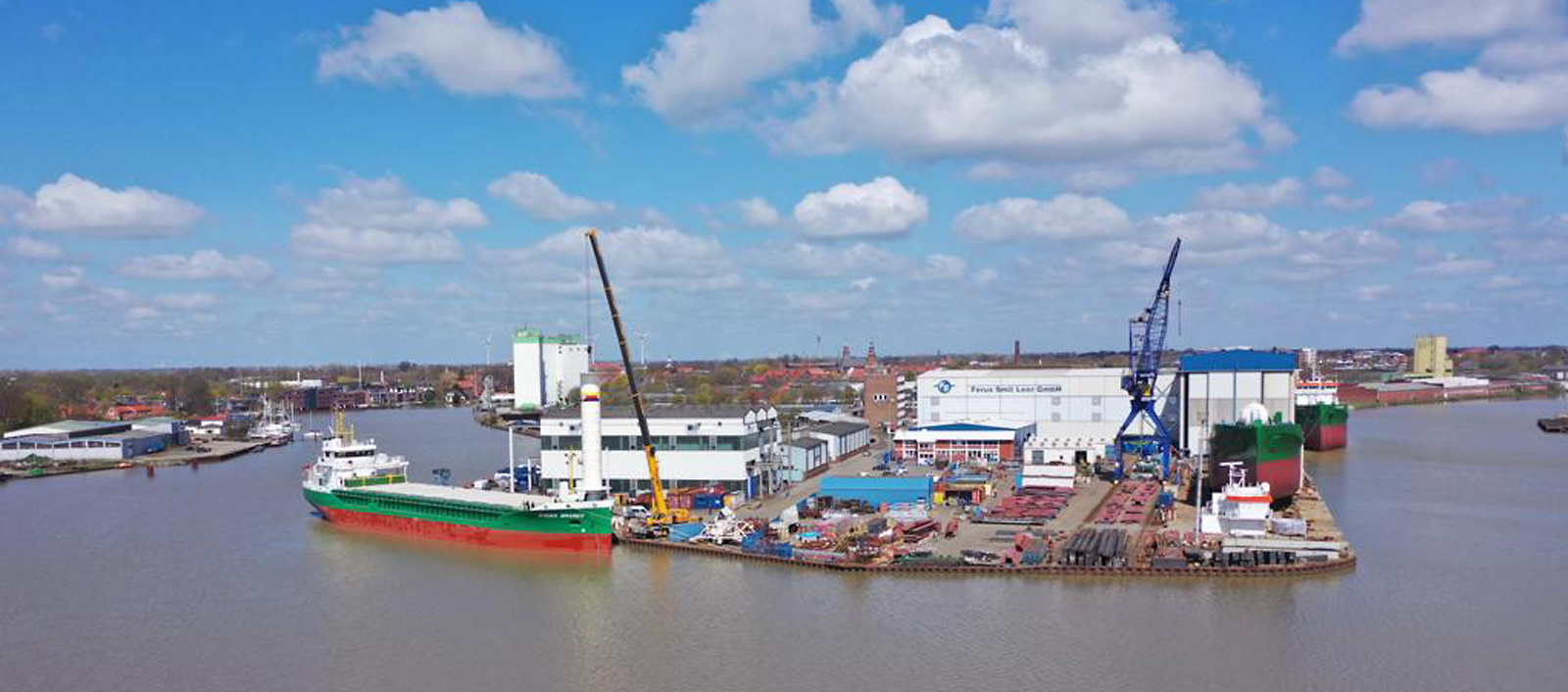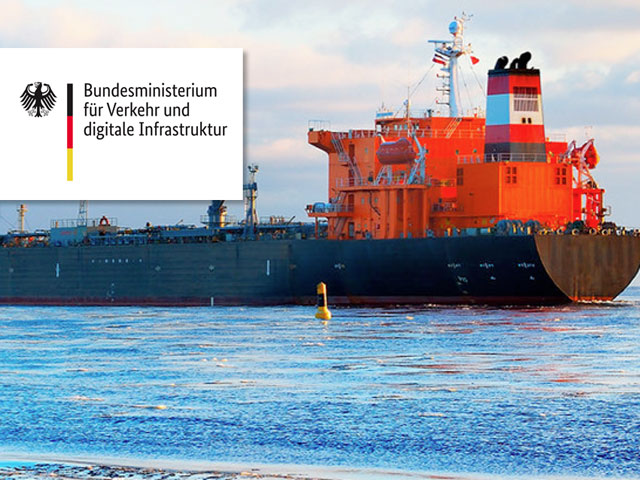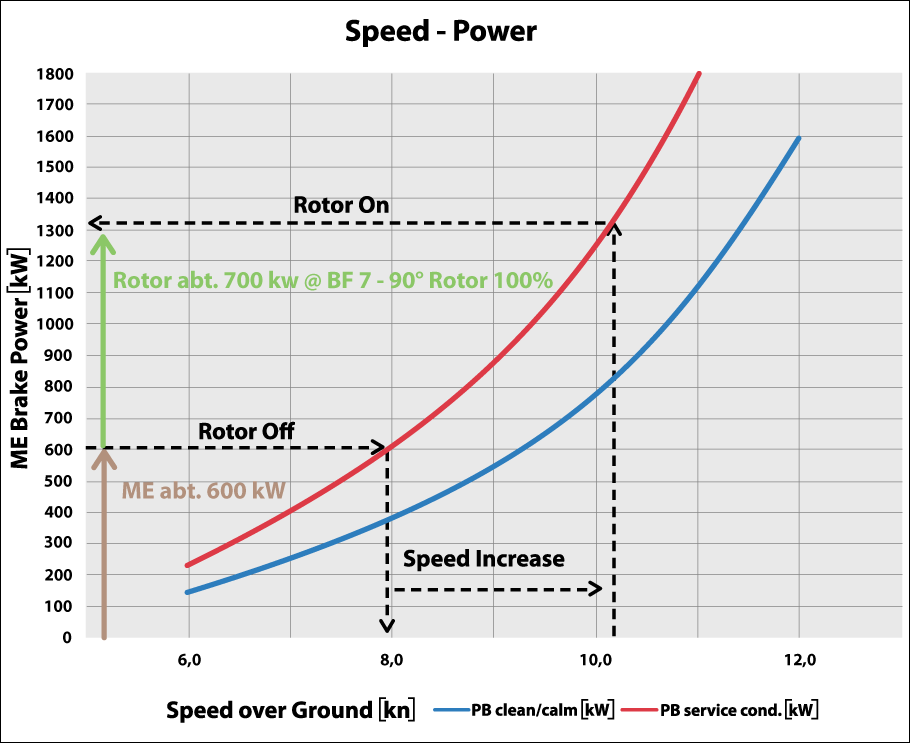

It’s a redesign of the Flettner concept which takes advantage of the so-called Magnus effect in the presence of side wind to produce additional thrust forward. The EF rotor in different sizes rotates around a pivot with upper and lower bearings. It has many innovative design features, such as lightweight materials and the ability to rotate at high speeds. The use of two end disks ensures very favourable flow conditions around the rotor.
The rotors acts additively to the propeller and with increasing sailing performance the main engine power is to be reduced efficiently. It is full functional and independent propulsion system. The crew can choose to utilize the extra thrust generated by the rotor to reduce engine power and fuel consumption, or to increase the ship’s speed.

| Sail surface (m2) | 54 |
| Diameter of upper and lower end disks [m] | 6 |
| Material | Rotor: GFP Mast: Steel |
| Rotor Speed (rpm) | Max. 280 |
| Lightning conductor / Ice prevention | yes / yes |
| Support structure | |
| Tower | Steel |
| Foundation height (typical) [m] | Hight between main deck and forecastle deck + 2300 mm over forecastle deck = approx. 5000 mm ⌀= approx. 2300 mm |
| Weight incl. typical foundation [tons] | Approx. 34 t / ship specific |
| Drive | Electric geared motor |
| Electric power (kW) | 75 |
| Variable speed drive | yes |
| Brake resistor / Mechanical lock | Electric Brake / yes |
| Control system software | yes |
| Hardware | yes |
| Condition Monitoring System | yes |
| Thrust Measurement System | yes |
| ATEX compliant design | on demand |
| Ambient conditions | |
| ATEX compliant design | on demand |
| Operational temperature | 40° C ambient temperature in the tower |
| Operational wind speed range | TADC (DNV GL) 30 m/s |
| Survival wind speed | TADC (DNV GL) 50 m/s |
| Thrust | Approx. 78 kN / BN9 (22,5 m/s) |
| Lead time (month) | 12 |
| Life Time (h) | Approx. 50.000 h in full load condition |
| Sail surface (m2) | 96 |
| Diameter of upper and lower end disks [m] | 8 |
| Material | Rotor: GFP Mast: Steel |
| Rotor Speed (rpm) | Max. 210 |
| Lightning conductor / Ice prevention | yes / yes |
| Support structure | |
| Tower | Steel |
| Foundation height (typical) [m] | Hight between main deck and forecastle deck + 2300 mm over forecastle deck = approx. 5000 mm ⌀= approx. 3300 mm |
| Weight incl. typical foundation [tons] | Approx. 43 t / ship specific |
| Drive | Electric geared motor |
| Electric power (kW) | 135 |
| Variable speed drive | yes |
| Brake resistor / Mechanical lock | Electric Brake / yes |
| Control system software | yes |
| Hardware | yes |
| Condition Monitoring System | yes |
| Thrust Measurement System | yes |
| ATEX compliant design | on demand |
| Ambient conditions | |
| ATEX compliant design | on demand |
| Operational temperature | 40° C ambient temperature in the tower |
| Operational wind speed range | TADC (DNV GL) 30 m/s |
| Survival wind speed | TADC (DNV GL) 50 m/s |
| Thrust | Approx. 139 kN / BN9 (22,5 m/s) |
| Lead time (month) | 12 |
| Life Time (h) | Approx. 50.000 h in full load condition |
| AT THE PLANNING STAGE | |
| Sail surface (m2) | 155 |
| Diameter of upper and lower end disks [m] | 10 |
| Material | Rotor: GFP Mast: Steel |
| Rotor Speed (rpm) | Max. 165 |
| Lightning conductor / Ice prevention | yes / yes |
| Support structure | |
| Tower | Steel |
| Foundation height (typical) [m] | Hight between main deck and forecastle deck + 2300 mm over forecastle deck = approx. 5000 mm ⌀= approx. 4300 mm |
| Weight incl. typical foundation [tons] | Approx. 53 t / ship specific |
| Drive | Electric geared motor |
| Electric power (kW) | 230 |
| Variable speed drive | yes |
| Brake resistor / Mechanical lock | Electric Brake / yes |
| Control system software | yes |
| Hardware | yes |
| Condition Monitoring System | yes |
| Thrust Measurement System | yes |
| ATEX compliant design | on demand |
| Ambient conditions | |
| ATEX compliant design | on demand |
| Operational temperature | 40° C ambient temperature in the tower |
| Operational wind speed range | TADC (DNV GL) 30 m/s |
| Survival wind speed | TADC (DNV GL) 50 m/s |
| Thrust | Approx. 247 kN / BN9 (22,5 m/s) |
| Lead time (month) | 12 |
| Life Time (h) | Approx. 50.000 h in full load condition |
| AT THE PLANNING STAGE | |
Download: 
For more information please click here: NaMKü


NO ADDITIONAL CREW REQUIRED ON BOARD
No set, trim or reef of sails
NO SAFETY RISKS IN SEVERE WEATHER
heavy weather sailing system
NO IMPACT IN THE CARGO OPERATIONS
An easy-to-use operating system is combined with intelligent voyage optimization programs
Fully automated and intelligent sailing system
Less CO2, SOx, NOx and other emissions
IMO – Improved energy Efficiency of ships (EEDI+EEXI)Charterer/Shipper benefit from improved carbon footprint on supply chain
Higher charter rate achievable due to fuel savings
The main question about modern rotor sailing systems is about the performance potential and fuel savings. For the prediction of the rotor’s propulsion power and associated fuel savings, numerous model tests and simulations were performed using the wind tunnel of TU Hamburg-Harburg and numerical CFD methods at the Center for Modelling and Simulation at the Emden/Leer University of Applied Sciences. Transparent performance data is required to enable an economic prognosis for the use of Flettner rotors on ships.
The expected performance figures are based on the test trails on MV Fehn Pollux (2018).
The savings potential depends on the wind conditions along the route and other factors. Precise predictions are made by route simulations for a specific ship.
In medium wind conditions the rotor sailing system produces 2 kW propulsion power per square meter. The amount of achievable savings depends on where the ship is in operation and the projected area.
For example: The EF18 rotor has a sail area (H × D) of 54 m2. Multiplied with 2 kW per square meter the EF18 produces 108 kW main engine equivalent power in annual average in a medium wind area and 162 kW (>3 kW) in very good wind areas. With this formula ship owners can calculate size and quantity of rotor sails, which are necessary to get a specific amount of fuel and emission savings.

Data collection and data evaluation by the University of Applied Sciences Emden/Leer, Germany, Prof. Capt. Michael Vahs, published in Schiff & Hafen Heft 2/2019, Germany
The rotor was used to increase the ship’s speed and compared with the equivalent power required for the main engine to achieve the same speed increase.
In normal charter service of MV Fehn Pollux, the main engine power is limited to about 650 kW (Eco-Speed). On MV Fehn Pollux average fuel savings in the range of 15–20% can be expected depending on the required ship speed and the sailing area.
Performance figures for the EF18 rotor under optimal wind conditions:
Yearly fuel and emission savings in automatic modus:
A thrust measuring system, a rotor control system and a crew training system are genuine innovations, which have been designed and developed by partners of the ECO FLETTNER project. A three-days crew training with the main focus on manoeuvring a rotor vessel has been implemented at the ship handling simulator of the company Nautitec in Leer. On request we offer a three-days training course.

Crew training

in the ship handling simulator

at the University Emden/Leer
MV Fehn Pollux in the ship yard SEC in Leer/Germany after rebuilding June 2018 with ECO FLETTNER.
During the docking of the MS Annika Braren, part of the Rörd Braren fleet, at the SEC shipyard in Leer/Germany, an ECO FLETTNER rotor sailing system was successfully installed in 12 days of construction on the one year old vessel.
ECO FLETTNER GmbH
Address:
Mühlenweg 5
D-26789 Leer/Germany
Phone: +49 (0) 491 9255523
Fax: +49 (0) 491 9255526
Mobil: +49 (0) 1724255028
Email: info@ecoflettner.de